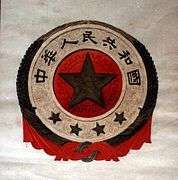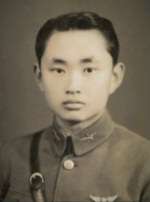Lin Huiyin
| Phyllis Lin | |
|---|---|
 | |
| Born |
10 June 1904 Hangzhou, Qing Dynasty |
| Died |
1 April 1955 (aged 50) Tongren Hospital, Beijing, People's Republic of China |
| Cause of death | Tuberculosis[1] |
| Resting place | Babaoshan Revolutionary Cemetery |
| Alma mater | University of Pennsylvania |
| Occupation | architect, poet |
| Spouse(s) | Liang Sicheng, m. 21 March 1928, wid. 1 April 1955 |
| Children |
Liang Congjie Liang Zaibing |
| Parent(s) |
Lin Changmin He Xuehuan |
| Relatives |
Lin Xiaoxun (林孝恂) (died 1914) (paternal grandfather) Lady You (遊氏) (paternal grandmother) Liang Qichao (father-in-law) |
Lin Huiyin (Chinese: 林徽因, born 林徽音; pinyin: Lín Huīyīn; known as Phyllis Lin or Lin Whei-yin when in the United States; 10 June 1904 – 1 April 1955) was a noted 20th-century Chinese architect and writer. She is known to be the first female architect in modern China and her husband the famed "Father of Modern Chinese Architecture" Liang Sicheng,[2] both of whom worked as founders and faculty in the newly formed Architecture Department of Northeastern University in 1928 and, after 1949, as professors in Tsinghua University in Beijing. Liang and Lin began restoration work on cultural heritage sites of China in the post-imperial Republican Era of China; a passion which she would pursue to the end of her life. The American artist Maya Lin is her niece.[3]
Biography
Lin was born in Hangzhou though her family was from Minhou (闽侯县), Fujian. She was the daughter of Lin Changmin (林長民) (16 September 1876 - Xinmin, Liaoning, 24 December 1925) and He Xueyuan (何雪媛) (1882–1972).
In a time when women had limited access to formal education, Lin was able to receive a formal education due to being part of a wealthy family. Because of her family's affluence she was able to travel extensively with her father. She obtained her degrees both in England and the United States. Lin first studied in London where she attended St Mary's College. It was there she became acquainted with the well known Chinese poet Xu Zhimo. Their relationship was a sensational part of Lin Huiyin's life and is referred to in romantic anecdotes. However, Lin's works are highly regarded. Lin wrote free verse, novels and prose. Lin's poems appeared in publications such as the Beijing Morning Post, Crescent Monthly, Poetry and the Dipper and the newspaper L'impartiale in Tianjin. In 1924, Lin and Liang Sicheng both enrolled at the University of Pennsylvania, where she also worked as a part-time assistant in the architectural department. Although they both wanted to attend the School of Architecture, Lin was not admitted because she was a woman. She therefore enrolled in the School of Fine Arts. Later, she enrolled in stage design programs in Yale University as a graduate student, pursuing her longtime interest in drama.[3] During her studies she pursued her passion of architecture by taking architectural classes.[4][5] It was here that Lin along with Liang Sicheng, her future husband whom she had known since childhood, pursued their love of architecture.
In April 1924, the sixty-four-year old Indian poet Tagore visited China, Lin Huiyin and Xu Zhimo worked together to do the interpretation work for Tagore, during which Lin Huiyin distinguished herself with her fluent English and also won the admiration of the poet.[6]
In the wake of the September 18th Incident, Lin left for Beijing, where she studied ancient Chinese architecture. Upon her return, she helped to establish the Architectural Department in Northeastern University in Shenyang, where she then taught architecture briefly.[7] Meanwhile, in 1928, she designed a railway station in Jilin. This was one of the few buildings Lin designed. Throughout the 1930s, Lin and her husband lived in Beiping, as Beijing was then called, near both of their families. Close friends at the time were the Americans Wilma and John K. Fairbank, who admired her sense of living on a “kind of double cultural frontier,” and facing the problem of “the necessity to winnow the past and discriminate among things foreign, what to preserve and what to borrow.”
In 1936, in order to deelop measurement records of the Chinese ancient architecture, Lin Huiyin and her husband climbed the roof of the Temple of Heaven; she became the first woman to attempt the walk on the emperor's palace roof. In 1937, she discovered the main hall of Foguang Temple near Doucun, Shanxi. The hall was the only remaining Tang dynasty timber structure known at the time.[8]
As Japan's invasion loomed, Lin Huiyin and her husband had to cut-short their promising restoration work of Beijing's cultural heritage sites in 1937 and abandoned their now famous courtyard residence in Beijing[9] to flee southward along with personnel and materials of the Architectural Department of Northeastern University; their exodus lead them and their children to temporary settlements in the cities of Tianjin, Kunming, and finally Lizhuang in 1940.[10] It was in Lizhuang where the bedridden Lin Huiyin, suffering from tuberculosis, was told of her younger brother's martyrdom while serving as a combat aviator in the air force in defense of Chengdu.[11] Lin wrote a poetic memorial commemorating her brother (opening excerpt):
Brother, I do not have words appropriate for this era to mourn over your death. This era made a simple request of you and you responded. Your absolute and simple heroism is a poem of this era. I want to add more sorrow to the unavoidable reality by screaming - you understand why - that you have gone too soon. Brother, your bravery is great. Your death is too cruel.
After 1949, Lin Huiyin became professor of architecture at Tsinghua University. Lin was involved in the design of the Chinese national flag, the National Emblem of the People's Republic of China and the Monument to the People's Heroes located in the Tiananmen Square. Lin designed the floral wreath patterns at the base of the Monument to the People's Heroes. Lin also took part in the standardization of Beijing city planning.
She died in 1955 of tuberculosis.[1]
Publications
Lin Huiyin wrote poems, essays, short stories and plays. Many of her works were praised for their subtlety, beauty, and creativity. Some of her more well known works are: Smile, Ninety-nine Degrees, Don't Let Our Land be Lost Again! and Meizhen and Them. Lin along with her husband wrote a book titled A Pictorial History of Chinese Architecture.[13] During this pursuit, Lin along with her husband went to thousands of ancient Chinese architectural sites. She conducted research and preserve China's architectural history. They lobbied hard to protect many of the old buildings in Beijing at a time when many parts of the city were being leveled by the municipal government.[14] She also translated English works into Chinese.
Legacy
In October, 2010, as part of a revival of Lin Huiyin and her husband's life accomplishments, CCTV broadcast a six-hour, eight-episode documentary on the husband and wife.[10] The documentary is titled Liang Sicheng Lin Huiyin and was directed by Hu Jingcao Although Lin did not receive the recognition due her, because she was a woman, there is now a renewed revival of her legacy. It has been quoted of Lin Huiyin that "It is often only through the light given off by a man that we see the woman behind him, particularly so for young women in the arts who emerged from the republican era. But Lin Huiyin is an exception. In her, we see the reflection of many outstanding men of the time, but in fact it is she who adds extra color and shine to their images."[15]
 Liang Sicheng, Lin Huiyin, Zhou Peiyuan and others
Liang Sicheng, Lin Huiyin, Zhou Peiyuan and others The jade disc design of the National Emblem of the People's Republic of China proposed by Lin Huiyin
The jade disc design of the National Emblem of the People's Republic of China proposed by Lin Huiyin
Notes
- 1 2 Andrew Jacobs, In Beijing’s Building Frenzy, Even an ‘Immovable Cultural Relic’ Is Not Safe, New York Times, New York edition, February 5, 2012, page A6
- ↑ http://www.huffingtonpost.com/artinfo/shady-beijing-developers-_b_1258101.html
- 1 2 Peter G. Rowe, Seng Kuan, Architectural Encounters With Essence and Form in Modern China, MIT Press, 2002, p.219, ISBN 0-262-68151-X
- ↑ Ideology and Culture in China; http://en.gmw.cn/2013-12/12/content_9786921_2.htm#Content_Title
- ↑ Donald Langmead (2011). Maya Lin: A Biography. Greenwood Biographies (illustrated ed.). ABC-CLIO. p. 19. ISBN 0313378533. Retrieved May 17, 2014.
- ↑ http://www.china.com.cn/book/txt/2009-03/26/content_17502241.htm
- ↑ Wiki China; http://wiki.china.org.cn/wiki/index.php/Lin_Huiyin
- ↑ John King Fairbank. Chinabound: A Fifty-Year Memoir. New York: Harper & Row, 1982. ISBN 0060390050, p. 106-108.
- ↑ http://en.bjchp.org/?page_id=2676
- 1 2 http://cctv.cntv.cn/lm/journeysintime/special/liangsicheng_linhuiyin/index.shtml
- 1 2 http://english.cntv.cn/program/journeysintime/20110524/108234.shtml
- ↑ http://www.flyingtiger-cacw.com/new_page_666.htm
- ↑ Amy D. Dooling, Kristina M. Torgeson, Writing Women in Modern China: An Anthology of Women's Literature from the Early Twentieth Century, Columbia University Press, 1998, p.301, ISBN 0-231-10701-3
- ↑ http://china.org.cn/english/NM-e/98587.htm
- ↑ The China Beat; http://www.thechinabeat.org/?p=2958
Further reading
| Wikimedia Commons has media related to Lin Huiyin. |
- Fairbank, Wilma. Liang and Lin: Partners in Exploring China's Architectural Past. University of Pennsylvania Press. 1994. ISBN 0-8122-3278-X
- Ch 9, “Chinese Friends,” John King Fairbank. Chinabound: A Fifty-Year Memoir. New York: Harper & Row, 1982. ISBN 0060390050), pp. 104–113.
- Sicheng Liang, translated by Wilma Fairbank. A Pictorial History of Chinese Architecture: A Study of the Development of Its Structural System and the Evolution of Its Types. (Cambridge, MA: MIT Press, 1984). ISBN 0262121034 Reprinted: Dover: 2005.
- Wong, Sidney (黄振翔). "Lin Huiyin (林徽因) and Liang Sicheng (梁思成) as Architectural Students at the University of Pennsylvania (1924-27)" Planning and Development Volume 23, No. 1, page 75-93, 2008.
